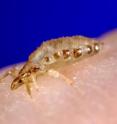Genome sequence may lead to better methods to target lice
A Purdue University researcher hopes a better understanding of the neurological system of the body louse through the mapping of its genome will lead to better control or elimination of the human parasite. Catherine Hill, an associate professor of entomology, with postdoctoral researchers Jason M. Meyer and Janice Pagel VanZee, and former undergraduate student Emily Krause contributed to the overall genome-mapping effort led by the University of Illinois and published online Monday (June 21) in the Proceedings of the National Academy of Sciences. The body louse genome is the smallest known genome of any insect, said University of Illinois entomology professor Barry Pittendrigh, who led the drive to fund the project and coordinated the international team of scientists who analyzed the sequence.
Purdue researchers described G protein-coupled receptors, responsible for neurological signaling and vision of the body louse (Pediculus humanus humanus).
"Because they're a part of the nervous system function, these receptors make great targets for new insecticides," Hill said.
The body louse is a close relative of the head louse, better known because of its association with schoolchildren. Both are human parasites that spread through contact among hosts and feed on human blood. Hill believes information gleaned from the body louse genome will be useful for controlling head lice as well, which have begun to resist current insecticides.
While lice are more of an embarrassment and do not spread diseases in the United States, they have been transmitters of epidemic typhus, relapsing fever and trench fever elsewhere. Lice can have serious effects in less-developed nations and have been known to spread in places where there is overcrowding and lack of sanitation, such as areas that have experienced a natural disaster.
In terms of the G protein-coupled receptors, Hill said the louse genome is quite basic. The louse has only 104 of the receptors, the smallest number seen in any sequenced insect. None of those receptors seem to be unique to just the louse.
"We were really excited because the louse genome enabled us to identify this core set of receptors that are conserved in many other insects," Hill said. "This suggests they have been retained throughout millions of years of evolution in multiple insects - they must perform important functions in the insect nervous system."
The receptors act as a message relay system, sitting half in and half out of the cell's membrane. Incoming messages in the form of molecules or light attach to the receptor, causing the receptor to pass the message into the cell. The cell then carries out a function based on that message.
The receptors make ideal targets for insecticide development since they control nervous system function. Insecticides can attach to and block or overstimulate those receptors, disrupting the relay of neurological messages and killing the louse.
Purdue researchers also found that the body louse has only three receptors related to vision, compared with seven to 12 found in most insects. Hill said the louse doesn't need finely tuned senses to survive.
"We think this reflects their parasitic lifestyle and the fact that they live in close association with their human host," Hill said. "Because body lice live in human clothing or bedding, they do not need to travel very far to seek out a blood meal from their host or to find a site to lay their eggs."
Hill's laboratory will use the receptors to design new insecticides that are specific to controlling lice, have low risk to humans and the environment, and can be used where other products have become ineffective due to resistance. The National Institutes of Health funded the louse genome project.
Source: Purdue University
Articles on the same topic
- Sequencing of the human body louse genomeTue, 22 Jun 2010, 14:17:38 UTC
- Of lice and man: Researchers sequence human body louse genomeMon, 21 Jun 2010, 19:34:04 UTC
Other sources
- Researchers sequence the human body lousefrom UPIWed, 23 Jun 2010, 20:50:15 UTC
- Clinically obsolete antibiotics could be used to treat head and body licefrom PhysorgWed, 23 Jun 2010, 18:31:04 UTC
- Sequencing of the human body louse genomefrom Biology News NetTue, 22 Jun 2010, 23:30:50 UTC
- Watch out lice, researchers are gunning for youfrom MSNBC: ScienceTue, 22 Jun 2010, 20:07:22 UTC
- Genome sequence may lead to better methods to target licefrom Science BlogTue, 22 Jun 2010, 16:01:17 UTC
- Genome sequence may lead to better methods to target licefrom Science BlogTue, 22 Jun 2010, 16:01:13 UTC
- Sequencing of the human body louse genome: Important step toward control of disease-vector insectfrom Science DailyTue, 22 Jun 2010, 15:31:57 UTC
- Genome sequence may lead to better methods to target licefrom Science DailyTue, 22 Jun 2010, 15:31:49 UTC
- Of lice and man: Researchers sequence human body louse genomefrom Science DailyTue, 22 Jun 2010, 3:34:25 UTC
- Sequencing Napoleon's nemesisfrom News @ NatureMon, 21 Jun 2010, 19:30:47 UTC
- ScienceShot: Body Louse Genome Reveals a Vulnerable Parasitefrom Science NOWMon, 21 Jun 2010, 19:20:25 UTC
- Of lice and man: Researchers sequence human body louse genomefrom PhysorgMon, 21 Jun 2010, 19:01:23 UTC
